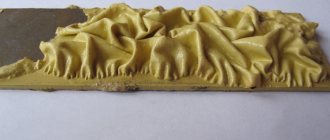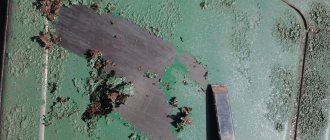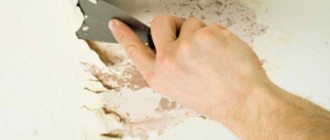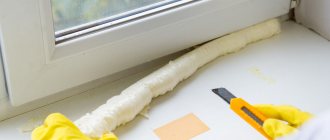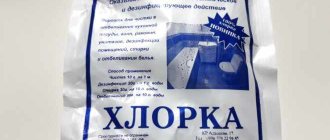0
09.11.2021
When carrying out renovation work in an apartment or private house, it often becomes necessary to remove paint from the wall. Most often, this is done before plastering or puttying the wall surface and further wallpapering. People who are going to prepare the walls themselves should figure out in advance how to properly remove paint at home.
Removing paint is a job that often has to be done during renovations in an apartment.
Is it always necessary to remove paint when repainting walls?
Page navigation
Many people who plan to repaint walls are wondering whether it is necessary to remove the old layer manually before doing so. Some people think that doing this is mandatory. However, sometimes you don't have to do this.
You can leave the old paint layer in the following cases:
- Leveling the wall surface. Some people cover it with special plasterboard sheets. In this case, you won't have to delete anything. They can simply be sewn on top of unprepared walls.
- Installation of lining. Sometimes the walls are lined with clapboard. It can also be installed over old paint.
Also, you should not clean it if the old layer is firmly in place. You can paint over it.
When is it necessary to remove old paint and why is it done?
Before you remove old paint from the walls in the kitchen, toilet, bathroom or regular room, you need to figure out when exactly this should be done.
Most often, it is removed if a large number of bubbles, cracks, chips and other mechanical damage appear on the surface. The fact is that such paint begins to peel off and therefore you will have to get rid of it in any case. In this case, it must be completely removed. This is done so that the new layer does not begin to peel off immediately after painting.
It is also recommended to remove paint before applying plaster or wallpaper to the walls. The fact is that paint has a rather low absorbency and therefore it is better to clean it off.
Most often it is necessary to remove acrylic, oil, water-based compositions and alkyd enamel from the walls.
Preparation for wallpaper
In order for the wallpaper to stick well, the layer on which it is attached must be stronger and heavier than it . If they weigh more, they will very soon simply move away from the wall. Therefore, all cracked paint must be cleaned off. Defects must be puttied.
You can check whether the wallpaper will be securely fixed in a simple way: apply glue to the wall and leave until completely dry. If it is securely fixed and does not come off in the form of a film, then you can start gluing.
Oil and alkyd paints are sanded with sandpaper. The formed depressions will improve the adhesion of the glue to the surface.
Before covering a wall with wallpaper, you need to remove dust and other contaminants from it, and then prime it . They will adhere firmly to such a surface, even if all the coloring composition is not cleaned off.
You should not glue light wallpaper to walls painted with dark paint. It will show through them in ugly spots.
How to strip different types of paintwork
Before removing paint from a wall, each person should familiarize themselves with the features of removing various compounds.
Water-based emulsion is a composition that can be removed with a regular rag soaked in water.
Water-based
Some people think that it is very difficult to clean water-based compounds from concrete walls, but this is far from the case. In fact, cleaning surfaces from such paint is quite easy and quick.
To wash the water-based emulsion, you need to moisten the wall with plain water. After some time, the layer will begin to gradually soften under the influence of moisture and can be removed using a regular spatula or rag. This must be done very carefully so as not to accidentally damage the surface.
It is worth noting that cleaning water-based emulsions is not always easy. In some cases, it is quite difficult to get rid of it. Most often, difficulties arise if a layer of varnish is applied on top. It will have to be additionally treated with special chemicals and solvents. Only after this will it be possible to clean off the varnish layer with a spatula.
If the layer of water-based paint applied is too thin, it should not be removed with a spatula. It can be washed off with a regular sponge.
Oily
Quite often, people involved in repairs are faced with the need to remove oil compounds. They are much more difficult to clean than water-based ones.
Oily compounds can be cleaned using special chemicals
There are several effective ways to remove such paint:
- Mechanical. In this case, a scraper, spatula or small hatchet is used to remove paint.
- Chemical. This method will help get rid of a thin layer of paint.
There is also a thermal method. When using it, the paintwork is removed with a construction hairdryer.
Acrylic
The easiest way to wash acrylic composition. The fact is that for this you can use a regular sponge dipped in water.
It is a little more difficult to remove from a wooden surface. You will have to use a spatula or knife.
To remove acrylic coating from a plastic surface, use detergents.
Do-it-yourself removal of different types of paint
There are recommendations for removing different types of paint. The choice of cleaning composition depends on this.
| Paint type | Preferred cleaning method |
| Oily | Mechanical or chemical cleaning method. |
| Acrylic | Solvents containing acetone or alcohols, mechanical cleaning. |
| Water-based | Mechanical method: with a grater or sandpaper. With a professional remover, or glue and newspaper. |
| Obsolete | It is best to combine several methods: large areas are treated with power tools, and hard-to-reach areas are treated with a remover or solvent. |
Thermal cleaning methods
To remove paint from concrete, some people use the thermal method. However, before removing paint from the walls using this method, you need to figure out what exactly can be used for heat treatment of surfaces.
An iron is a fairly common element of household appliances, which is often used to clean walls from old layers of paint.
Home iron
Not every person has professional tools with which to get rid of the paint layer. If you don’t have a hair dryer at home, you can use an ordinary household iron instead. It will allow you to get rid of any paintwork.
To use it to remove paint when preparing walls for wallpapering, you must:
- Heat the iron to maximum temperature.
- Tear off a sheet of foil at least 25-30 centimeters long.
- Warm up sections of the walls through a piece of foil.
After the surface is well heated, you can remove the remaining paint with a spatula.
Construction hair dryer
It is best to use a construction hair dryer to thermally clean the walls from paint residues. This is a fairly powerful tool that allows you to heat the air to 550-650 °C. Thanks to this, it can be used to melt any paint composition.
The advantages of this tool include its versatility. The fact is that with its help you can clean not only concrete, but also wooden surfaces with your own hands. Some people use a hair dryer to remove paint on tiles.
A spatula is a tool that can be used to quickly clean off peeling paint.
Using a wash
In some cases, the paint can simply be washed off the wall. This method is considered the safest, since when using it there is minimal risk of damaging the wall covering or knocking off and scraping off the plaster.
To remove the paintwork you will need the following tools:
- Brush with spatula. They will come in handy if the layer is too thick.
- Cleaner and rag. Using a cloth soaked in warm water can remove any traces of paint.
- Sandpaper. You will need it to get rid of marks that could not be washed off with water.
Before you start washing, you must put on protective gloves.
Then you should start preparing the walls. They must be swept in advance with a broom. After this, the surface must be moistened with a washing solution.
After 12-15 hours, the coating will gradually begin to crack and delaminate. It must be treated with a spatula to get rid of peeling paint.
Then you need to clean the wall with a metal brush and sandpaper.
The cleaned wall must be thoroughly rinsed and dried.
Mechanical methods
If it is not possible to clean the wall using the above methods, you will have to use mechanical cleaning methods. With their help you will be able to get rid of any paintwork.
Sandblasting machine - ideal for processing metal surfaces
Sandblasting
This is one of the most common methods of mechanical paint removal. To use this technique, you will have to acquire a sandblasting machine. It is equipped with a special nozzle from which the sand mixture flies out during the cleaning process. This abrasive is quite powerful and can be used to remove any paint.
It is worth noting that sandblasting can only be used when working with metal surfaces. For example, this method is definitely not suitable for cleaning wooden surfaces.
Using a brush
People who have an angle grinder or a drill can purchase a special brush for such tools. It is suitable for processing concrete, metal and wood. With the help of such a brush, you can even remove multi-layer paintwork. However, this is a slow process that can take several hours.
This method has disadvantages. Among the disadvantages is that it is impossible to clean hard-to-reach pestles with a brush. It also begins to generate a lot of dust when processing concrete surfaces.
Sandpaper
Sandpaper is often used when processing metal surfaces. However, it is also suitable for cleaning walls from remaining paint.
Most often it is used together with chemical solvents. If the paint layer is too thin, you can wipe it off with sandpaper without chemicals. In this case, it is better to use fine-grained sandpaper so as not to leave too many marks on the wall.
Sandpaper - can clean walls from paint residues
How and how to remove old paint from walls, ceilings and floors
Let's start with the first factor - the type of paint, which depends on the type of film-forming base that binds the coloring pigments into a single homogeneous mass. Full characteristics and markings of paints are presented in the table. We will focus on some of the most popular types.
- Water-based paint
. Coloring pigments are distributed in a water base. But, despite this, the water-based emulsion is not washed off with water after hardening. This is perhaps the only type of paint that can be applied to any other without the risk of ruining the work. - Acrylic paint
. It is made on the basis of acrylic resin. It is characterized by elasticity, frost resistance, low gas impermeability, strength and resistance to ultraviolet radiation. - Oil paint
. Everyone who received an apartment from the state faced the issue of its removal. The basis for its production is drying oil, and the binding component is alkyd resin. Over time, a surface painted with oil paint loses its color, but, nevertheless, the paint does not lose its structure.
The base of the paint determines the degree of its wear resistance.
The second factor, the type of surface, is also important. It influences the way paint is removed.
Choosing the right cleaning method
Many people have certain difficulties when choosing the most suitable cleaning method. There are several criteria that should be taken into account:
- Type of paint used. It is imperative to pay attention to what exactly the wall is painted with. If oil formulations were used, it is better to use thermal and mechanical methods. A remover is suitable for removing acrylic.
- Covering material. Mechanical cleaning is ideal for treating metal or concrete surfaces. It is better to remove paint from wood using a remover.
- Layer thickness. If it is too thick, you will have to use mechanical cleaning. To get rid of a thin layer of acrylic, a wet rag is enough.
If desired, you can combine several methods at once.
Removing Oil Paint
For the most persistent oil composition, there are several more removal methods:
- Foil + iron. The foil is applied to the painted wall and ironed with a hot iron. The softened coating is removed with a spatula.
- Liquid glass. The wall is covered with this material; after complete drying, the liquid glass forms a film that can be removed along with the paint.
- Lime + potassium carbonate (soda ash). A solution of components with a 3:1 ratio is applied to the wall for 12 hours, then the oil coating is removed with a spatula. The lime must be quicklime.
USEFUL INFORMATION: Secrets of preparing walls for wallpapering
It is not always possible to determine the characteristics of the composition applied to the wall. To understand the best way to clean the surface, experiment with a small area of the coating. Test samples will not only help you choose an effective method for removing paint, but will also allow you to find out what material the walls are made of and how many layers of finishing material are applied to them.
Safety precautions
Before you clean the walls of old paint, you should familiarize yourself with safety precautions.
When removing paint, you must wear special protective equipment.
There are several recommendations that you should definitely heed:
- The work must be done using protective equipment. It is recommended to wear rubber gloves and safety glasses. Especially if during work you have to treat the walls with a solvent.
- Cleaning should only be done in a ventilated area. It is necessary to open the vents and windows to allow more fresh air to enter.
- Before using chemical cleaners, be sure to read the instructions.
When renovating a home, many people have to peel off old paint from the walls. However, before doing such a difficult job, it is recommended that you familiarize yourself with the main types of paint and varnish coatings. You also need to understand the most effective cleaning methods and the features of their application in practice.
